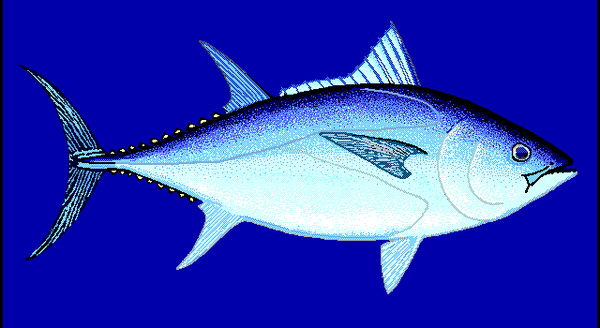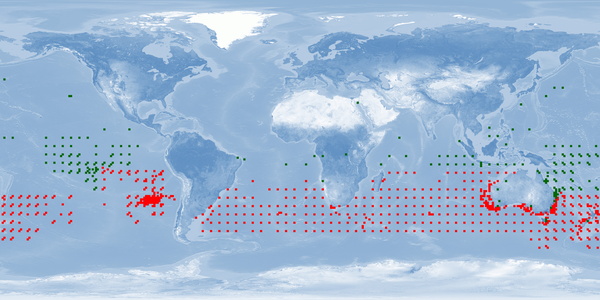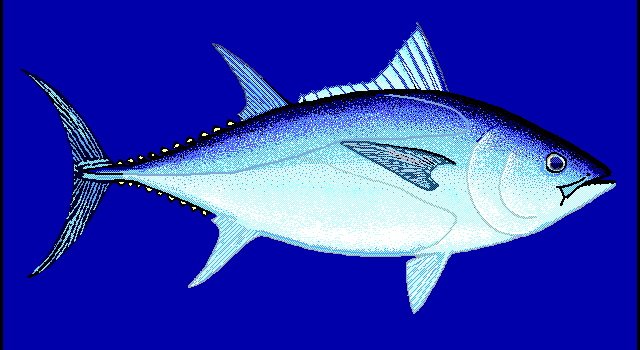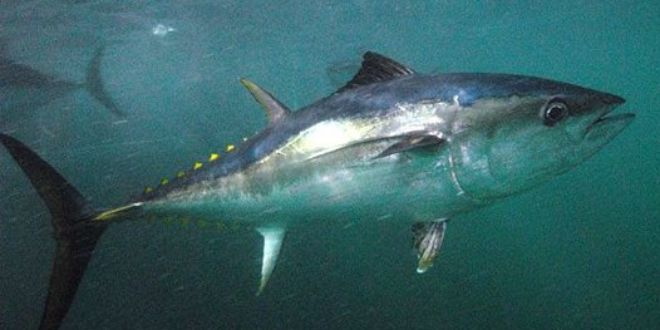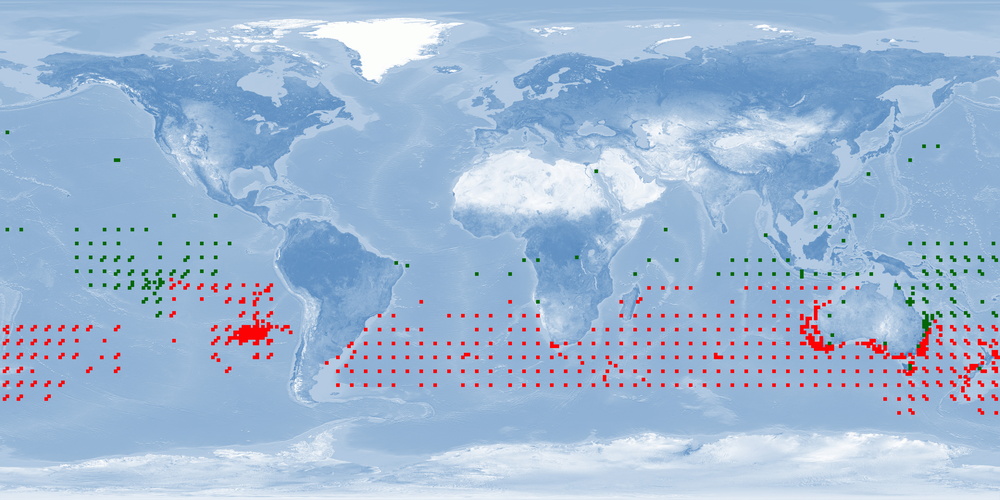Information
Version: B | 1.1 (2021-12-20)
Please note: This part of the profile is currently being revised.
WelfareScore | farm
Condensed assessment of the species' likelihood and potential for good fish welfare in aquaculture, based on ethological findings for 10 crucial criteria.
- Li = Likelihood that the individuals of the species experience good welfare under minimal farming conditions
- Po = Potential of the individuals of the species to experience good welfare under high-standard farming conditions
- Ce = Certainty of our findings in Likelihood and Potential
WelfareScore = Sum of criteria scoring "High" (max. 10)
General remarks
Farming of Thunnus maccoyii started in the 1970s mainly in Australia and Japan as a solution for the observed depletion of stocks and its high market value. This warm-blooded fish is an ocean cruiser, and therefore solutions for farming will be hampered by its need for space. There is already a fair amount of research on this species, but more knowledge is necessary regarding social interactions, stress, malformations and on the development of a humane stunning and slaughter method. Although it is mostly farmed from wild-caught individuals, rearing and housing of spawners should be improved.
1 Home range
Many species traverse in a limited horizontal space (even if just for a certain period of time per year); the home range may be described as a species' understanding of its environment (i.e., its cognitive map) for the most important resources it needs access to.
What is the probability of providing the species' whole home range in captivity?
It is low for minimal and high-standard farming conditions. Our conclusion is based on a high amount of evidence.


2 Depth range
Given the availability of resources (food, shelter) or the need to avoid predators, species spend their time within a certain depth range.
What is the probability of providing the species' whole depth range in captivity?
It is unclear for minimal farming conditions. It is medium for high-standard farming conditions. Our conclusion is based on a medium amount of evidence.


3 Migration
Some species undergo seasonal changes of environments for different purposes (feeding, spawning, etc.), and to move there, they migrate for more or less extensive distances.
What is the probability of providing farming conditions that are compatible with the migrating or habitat-changing behaviour of the species?
It is low for minimal and high-standard farming conditions. Our conclusion is based on a medium amount of evidence.


4 Reproduction
A species reproduces at a certain age, season, and sex ratio and possibly involving courtship rituals.
What is the probability of the species reproducing naturally in captivity without manipulation of theses circumstances?
It is low for minimal farming conditions. It is medium for high-standard farming conditions. Our conclusion is based on a high amount of evidence.


5 Aggregation
Species differ in the way they co-exist with conspecifics or other species from being solitary to aggregating unstructured, casually roaming in shoals or closely coordinating in schools of varying densities.
What is the probability of providing farming conditions that are compatible with the aggregation behaviour of the species?
It is unclear for minimal farming conditions. It is high for high-standard farming conditions. Our conclusion is based on a medium amount of evidence.


6 Aggression
There is a range of adverse reactions in species, spanning from being relatively indifferent towards others to defending valuable resources (e.g., food, territory, mates) to actively attacking opponents.
What is the probability of the species being non-aggressive and non-territorial in captivity?
There are no findings for minimal and high-standard farming conditions.


7 Substrate
Depending on where in the water column the species lives, it differs in interacting with or relying on various substrates for feeding or covering purposes (e.g., plants, rocks and stones, sand and mud, turbidity).
What is the probability of providing the species' substrate and shelter needs in captivity?
It is high for minimal and high-standard farming conditions. Our conclusion is based on a high amount of evidence.


8 Stress
Farming involves subjecting the species to diverse procedures (e.g., handling, air exposure, short-term confinement, short-term crowding, transport), sudden parameter changes or repeated disturbances (e.g., husbandry, size-grading).
What is the probability of the species not being stressed?
It is unclear for minimal farming conditions. It is medium for high-standard farming conditions. Our conclusion is based on a low amount of evidence.


9 Malformations
Deformities that – in contrast to diseases – are commonly irreversible may indicate sub-optimal rearing conditions (e.g., mechanical stress during hatching and rearing, environmental factors unless mentioned in crit. 3, aquatic pollutants, nutritional deficiencies) or a general incompatibility of the species with being farmed.
What is the probability of the species being malformed rarely?
It is unclear for minimal and high-standard farming conditions. Our conclusion is based on a low amount of evidence.


10 Slaughter
The cornerstone for a humane treatment is that slaughter a) immediately follows stunning (i.e., while the individual is unconscious), b) happens according to a clear and reproducible set of instructions verified under farming conditions, and c) avoids pain, suffering, and distress.
What is the probability of the species being slaughtered according to a humane slaughter protocol?
It is low for minimal farming conditions. It is medium for high-standard farming conditions. Our conclusion is based on a medium amount of evidence.


Side note: Domestication
Teletchea and Fontaine introduced 5 domestication levels illustrating how far species are from having their life cycle closed in captivity without wild input, how long they have been reared in captivity, and whether breeding programmes are in place.
What is the species’ domestication level?
DOMESTICATION LEVEL 3 27, level 5 being fully domesticated.
Side note: Forage fish in the feed
450-1,000 milliard wild-caught fishes end up being processed into fish meal and fish oil each year which contributes to overfishing and represents enormous suffering. There is a broad range of feeding types within species reared in captivity.
To what degree may fish meal and fish oil based on forage fish be replaced by non-forage fishery components (e.g., poultry blood meal) or sustainable sources (e.g., soybean cake)?
WILD: carnivorous 18. FARM: juveniles and adults are fed with baitfish 28 2, spawners with pilchards and squid 2; replacement of fish meal and fish oil is not reported.
Glossary
DOMESTICATION LEVEL 3 = entire life cycle closed in captivity with wild inputs 27
FARM = setting in farming environment or under conditions simulating farming environment in terms of size of facility or number of individuals
JUVENILES = fully developed but immature individuals, for details ➝ Findings 10.1 Ontogenetic development
LARVAE = hatching to mouth opening, for details ➝ Findings 10.1 Ontogenetic development
OCEANODROMOUS = living and migrating in the sea
SPAWNERS = adults during the spawning season; in farms: adults that are kept as broodstock
WILD = setting in the wild
Bibliography
2 Chen, Ben Nan, Wayne Hutchinson, and Craig Foster. 2015. Southern Bluefin Tuna Captive Breeding in Australia. In Advances in Tuna Aquaculture: From Hatchery to Market, 233.
3 Davis, Tim L. O., and Clive A. Stanley. 2002. Vertical and horizontal movements of southern bluefin tuna (Thunnus maccoyii) in the Great Australian Bight observed with ultrasonic telemetry. Fishery Bulletin 100: 448–465.
4 Hayward, Craig J., Hamish M. Aiken, and Barbara F. Nowak. 2007. Metazoan parasites on gills of Southern Bluefin Tuna (Thunnus maccoyii) do not rapidly proliferate after transfer to sea cages. Aquaculture 262: 10–16. https://doi.org/10.1016/j.aquaculture.2006.09.041.
5 Hayward, Craig J, Hamish M Aiken, and Barbara F Nowak. 2008. An epizootic of Caligus chiastos on farmed southern bluefin tuna Thunnus maccoyii off South Australia. Diseases of aquatic organisms 79: 57–63.
6 Pedersen, M. W., T. A. Patterson, U. H. Thygesen, and H. Madsen. 2011. Estimating animal behavior and residency from movement data. Oikos 120: 1281–1290. https://doi.org/10.1111/j.1600-0706.2011.19044.x.
7 Lioka, C, K Kani, and H Nhhala. 2000. Present status and prospects of technical development of tuna sea-farming. Cahiers Options Méditerranéennes 47: 275–285.
8 Davis, Tim L. O., Greg P. Jenkins, and Jock W. Young. 1990. Diel patterns of vertical distribution in larvae of southern bluefin Thunnus maccoyii, and other tuna in the East Indian Ocean. Marine Ecology Progress Series 59: 63–74. https://doi.org/10.2307/24842422.
9 Patterson, Toby A., Karen Evans, Thor I. Carter, and John S. Gunn. 2008. Movement and behaviour of large southern bluefin tuna (Thunnus maccoyii) in the Australian region determined using pop-up satellite archival tags. Fisheries Oceanography 17: 352–367. https://doi.org/10.1111/j.1365-2419.2008.00483.x.
10 Willis, Jay, John Phillips, Rachel Muheim, Francisco Javier Diego-Rasilla, and Alistair J. Hobday. 2009. Spike dives of juvenile southern bluefin tuna (Thunnus maccoyii): a navigational role? Behavioral Ecology and Sociobiology 64: 57. https://doi.org/10.1007/s00265-009-0818-2.
11 Glencross, Brett D., Steven M. Clarke, Jeffery G. Buchanan, Chris G. Carter, and Robert J. van Barneveld. 2002. Temporal Growth Patterns of Farmed Juvenile Southern Bluefin Tuna, Thunnus maccoyii (Castelnau) Fed Moist Pellets. Journal of the World Aquaculture Society 33: 138–145. https://doi.org/10.1111/j.1749-7345.2002.tb00488.x.
12 Collette, B. B., and C. E. Nauen. 1983. FAO species catalogue. Vol. 2. Scombrids of the world. An annotated and illustrated catalogue of tunas, mackerels, bonitos and related species known to date. Vol. 2. FAO Fisheries Synopsis 125. Rome, Italy: Food and Agriculture Organization of the United Nations.
13 Hobday, Alistair, Karen Evans, J Eveson, Jessica Farley, Jason Hartog, Marinelle Basson, and Toby Patterson. 2015. Distribution and Migration—Southern Bluefin Tuna (Thunnus maccoyii). In Biology and Ecology of Bluefin Tuna, ed. Takashi Kitagawa and Shingo Kimura, 189–210. CRC Press. https://doi.org/10.1201/b18714-12.
14 Fujioka, Ko, Alistair J. Hobday, Ryo Kawabe, Kazushi Miyashita, Yoshimi Takao, Osamu Sakai, and Tomoyuki Itoh. 2012. Departure behaviour of juvenile southern bluefin tuna (Thunnus maccoyii) from southern Western Australia temperate waters in relation to the Leeuwin Current. Fisheries Oceanography 21: 269–280. https://doi.org/10.1111/j.1365-2419.2012.00620.x.
15 Farley, Jessica H, and Tim L. O. Davis. 1998. Reproductive dynamics of Thunnus maccoyii. Fishery Bulletin 96: 223–236.
16 Evans, Karen, Toby A. Patterson, Howard Reid, and Shelton J. Harley. 2012. Reproductive Schedules in Southern Bluefin Tuna: Are Current Assumptions Appropriate? PLoS ONE 7. https://doi.org/10.1371/journal.pone.0034550.
17 Davis, T. L. O., V. Lyne, and G. P. Jenkins. 1991. Advection, dispersion and mortality of a patch of southern bluefin tuna larvae Thunnus maccoyii in the East Indian Ocean. Marine Ecology Progress Series 73: 33–45. https://doi.org/10.2307/24825390.
18 Olson, Robert J. 1980. Synopsis of biological data on the southern bluefin tuna, Thunnus maccoyii (Castelnau, 1872).
19 Willis, Jay. 2008. Simulation model of universal law of school size distribution applied to southern bluefin tuna (Thunnus maccoyii) in the Great Australian Bight. Ecological Modelling 213: 33–44. https://doi.org/10.1016/j.ecolmodel.2008.01.017.
20 Newlands, Nathaniel K, and Tracy A Porcelli. 2008. Measurement of the size, shape and structure of Atlantic bluefin tuna schools in the open ocean. Fisheries Research 91: 42–55.
21 Thomas, P M, C G Carter, J F Carragher, and B D Glencross. 2003. Preliminary information on temporal changes in the blood chemistry of farmed southern bluefin tuna, Thunnus maccoyii (Castelnau), after feeding and repeated sampling disturbance. Aquaculture Research 34: 265–267. https://doi.org/10.1046/j.1365-2109.2003.00812.x.
22 Kirchhoff, Nicole T., Kirsty M. Rough, and Barbara F. Nowak. 2011. Moving Cages Further Offshore: Effects on Southern Bluefin Tuna, T. maccoyii, Parasites, Health and Performance. PLOS ONE 6: e23705. https://doi.org/10.1371/journal.pone.0023705.
23 Woolley, Lindsey D., Stewart D. Fielder, and Jian G. Qin. 2013. Swimbladder inflation associated with body density change and larval survival in southern bluefin tuna Thunnus maccoyii. Aquaculture International 21: 1233–1242. https://doi.org/10.1007/s10499-013-9626-9.
24 Hilder, P. I. 2013. Development of vision and larval feeding responses in southern bluefin tuna and yellowtail kingfish. Phd, University of Tasmania.
25 European Food Safety Authority (EFSA). 2009. Species-specific welfare aspects of the main systems of stunning and killing of farmed tuna. EFSA Journal 1072: 1–53. https://doi.org/10.2903/j.efsa.2009.1072.
26 De La Gandara, F. 2015. Cultured Aquatic Species Information Programme. Thunnus thynnus. Rome: FAO Fisheries and Aquaculture Department.
27 Teletchea, Fabrice, and Pascal Fontaine. 2012. Levels of domestication in fish: implications for the sustainable future of aquaculture. Fish and Fisheries 15: 181–195. https://doi.org/10.1111/faf.12006.
28 Ellis, David, and Ilse Kiessling. 2015. Ranching of southern blufin tuna in Australia. In Advances in Tuna Aquaculture: From Hatchery to Market, 217.




